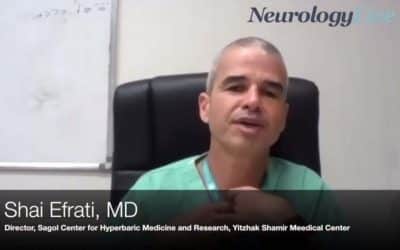From Neurology Live. The director of the Sagol Center for Hyperbaric Medicine and Research at Yitzhak Shamir Medical Center discusses how hyperbaric oxygen therapy is being used to attempt to improve the damage from neurodegeneration.
Stem Cell News
A Dual Role for Hyperbaric Oxygen in Stroke Neuroprotection: Preconditioning of the Brain and Stem Cells.
Stroke continues to be an extremely prevalent disease and poses a great challenge in developing safe and effective therapeutic options. Hyperbaric oxygen therapy (HBOT) has demonstrated significant pre-clinical effectiveness for the treatment of acute ischemic stroke, and limited potential in treating chronic neurological deficits. Reported benefits include reductions in oxidative stress, inflammation, neural apoptosis, and improved physiological metrics such as edema and oxygen perfusion, all of which contribute to improved functional recovery.
Increased circulating stem cells and better cognitive performance in traumatic brain injury subjects following hyperbaric oxygen therapy.
Traumatic brain injury (TBI) may cause persistent cognitive dysfunction. A pilot clinical study was performed to determine if hyperbaric oxygen (HBO₂) treatment improves cognitive performance. It was hypothesized that stem cells, mobilized by HBO₂ treatment, are recruited to repair damaged neuronal tissue. This hypothesis was tested by measuring the relative abundance of stem cells in peripheral blood and cognitive performance during this clinical trial. The subject population consisted of 28 subjects with persistent cognitive impairment caused by mild to moderate TBI suffered during military deployment to Iraq or Afghanistan. Fluorescence-activated cell sorting (FACS) analysis was performed for stem cell markers in peripheral blood and correlated with variables resulting from standard tests of cognitive performance and post-traumatic stress disorder: ImPACT, BrainCheckers and PCL-M test results. HBO₂ treatment correlated with stem cell mobilization as well as increased cognitive performance. Together these results support the hypothesis that stem cell mobilization may be required for cognitive improvement in this population.
Primary patient-derived lung adenocarcinoma cell culture challenges the association of cancer stem cells with epithelial-to-mesenchymal transition.
Abstract: The cancer stem cell (CSC) and epithelial-to-mesenchymal transition (EMT) models have been closely associated and used to describe both the formation of metastasis and therapy resistance. We established a primary lung cell culture from a patient in a...




